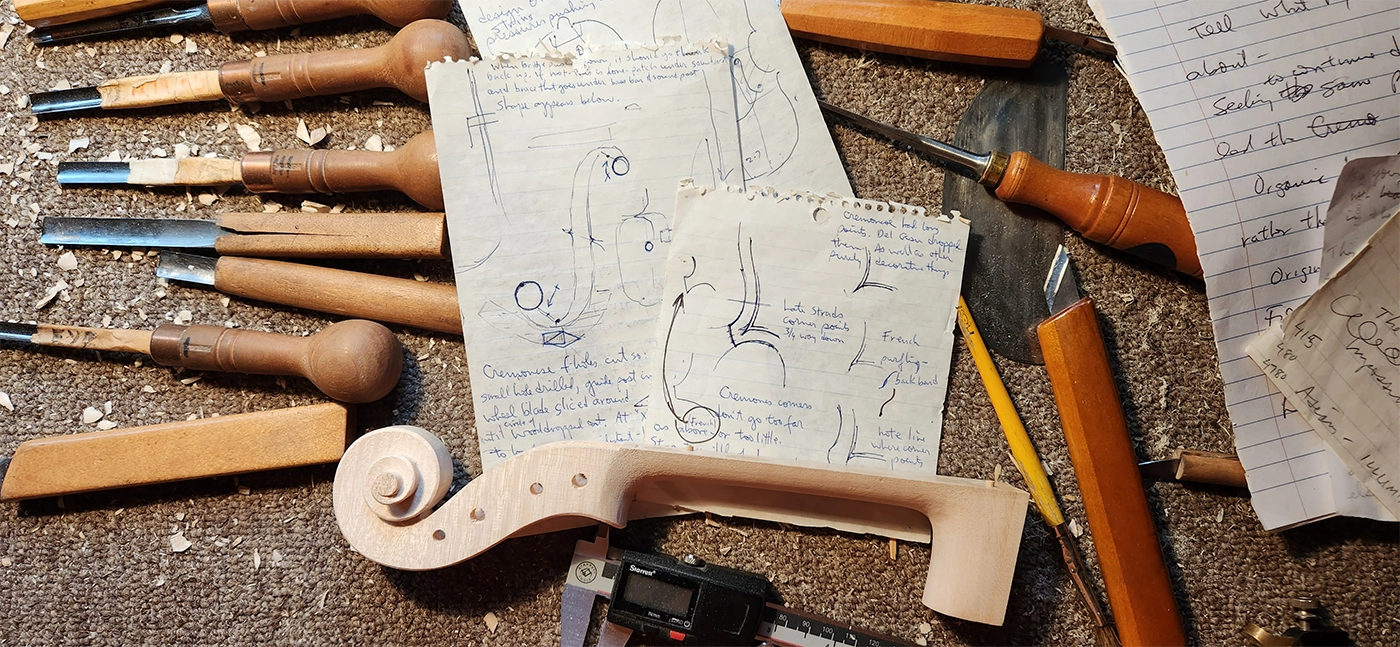Introduction to the Article and Visit to Charles Beare's London Shop
In December 21, 1976, Charles Rufino had a unique opportunity to study a breathtaking collection of rare master Italian violins at the renowned violin shop of J&A Beare in London, England. Charles Beare welcomed a group of young violin makers into his shop for a personal encounter with historical instruments, which provided a rare glimpse into the artistry and techniques behind some of the most iconic violins in history.
Exploring Charles Rufino's 1976 Visit to J & A Beare’s London Shop
Discovering Rare Stradivari and Guarneri Violins
As we were escorted downstairs to the private rooms a stunning selection of master instruments awaited us. There were 8 or 9 early Stradivari violins among them, the 1666 Serdet, the earliest known Stradivari violin- still in pieces and unrestored. One Golden Period from 1716, the Berthier provided a fascinating opportunity to contrast the work of the youthful maker with the mature master. The a number of Amati violins and several exemplary Guarneri instruments, including a pristine 1711 Joseph filius Andrea and the celebrated Vieuxtemps Del Gesu, today owned by Anne Akiko Meyers.
Insights into Techniques of Violin Making
Charles Beare shared insights into his experience of Italian varnishes, pointing out that Italian varnishes are soluble in ethyl alcohol. While this widely acknowledged today, as young students hearing differing opinions from all sides, we took in his words with the keenest interest imaginable!
Cremonese Purfling: Pearwood and White Woods
A conversation about purfling arose, with Charles explaining that Cremonese violin makers utilized pearwood dyed black, along with various white woods such as poplar, lime, and maple.
Viola Fingerboard Radius and Romberg Influence
Curious minds inquired about the shape of viola fingerboards coming out of the Beare shop- in those years many violas still had the Rombers the flat platform under the C-string common in cellos Trend-setters like Beare’s were moving to the violin style fingerboard common today. Charles attributed this to the guidance of Simone Sacconi, with whom he studied in the late 60s in New York, Sacconi was the legendary expert maker and restorer who trained the generation of makers active in the late 20th and early 21st Century, such as Charles Beare, Rene Morel, and many other luminaries, who trained the generation to which I belong.
Violin Thickness and Density Considerations
Charles delved into the nuanced world of violin thickness and density. He disclosed that Sacconi's observations indicated consistent thicknesses, with the back thickest in the acoustic center becoming thinner towards the edges and an even thickness in the belly. The interplay of springiness, weight, and density plays a crucial role in shaping a violin's tonal character.
Conversations on Violin Construction
Understanding Violin Back and Belly Thickness
We pressed him more on the thickness of a violin's back and belly. Charles shared his observations of a top-tier Del Gesu violin boasting a nearly 7mm thick back, caused by a very pointy outside arching. Thus he believed the inside shape held greater significance, influencing the instrument's tonal qualities more than the outside arching..
The Delicate Interplay of Violin Arching and thickness
Charles shared his perspective on arching, highlighting its pivotal role in the violin's sound. He narrated that the arching allows the violin to be made thin enough to resonate while withstanding the string pressure, maintaining its exquisite tonal qualities.
Uncovering Violin Wood Selection
Exploring Willow, Poplar, and Lime Woods
The choice of wood for violins was a topic of interest. Charles praised willow, poplar, and lime woods, highlighting their affordability and exceptional tonal properties. These woods, often overlooked, have contributed to the creation of remarkable instruments.
Pearwood and Maple in Violin Crafting
Diving deeper into wood choices, Charles revealed that pearwood dyed black was favored for purfling, while maple played a role in shaping various components of the violin.
The Wisdom of Charles Beare
Carl Becker: The Greatest Living Violin Maker
In response to a question about the greatest living maker, Charles named Carl Becker. This acknowledgment fueled my ambition to one day work and study under this contemporary master, an ambition I was able to fulfill just 4 years later
A Glimpse into Unfinished Masterpieces
Charles shared an anecdote about a viola he had started decades ago and never completed. Opening the case, he discovered 50 Deutschmarks—a testament to his remarkable memory and the quirks of his journey.
Anecdotes and Insights from the Legendary Visit
In this unique encounter, Charles Beare's insights into violin craftsmanship, historical methods, wood choices, and varnishing techniques provide a rich tapestry of knowledge. His anecdotes and responses paint a vivid picture of a master violinmaker's journey.
Conclusion: Wrapping Up Charles Beare's 1976 Visit and Its Significance
As we reflect on Charles Beare's visit to Beare’s in 1976, we gain a deeper understanding of the intricate artistry and craftsmanship that define the world of violin making. His revelations about historical techniques, wood selection, and the delicate nuances of instrument construction continue to resonate with violin enthusiasts and craftsmen alike.
 Charles J. Rufino is a violin maker in New York. Since 1974 he has been immersed in the world of the violin, as apprentice, journeyman, and today, as master craftsman creating concert instruments.
Charles J. Rufino is a violin maker in New York. Since 1974 he has been immersed in the world of the violin, as apprentice, journeyman, and today, as master craftsman creating concert instruments.
To learn more about Charles Rufino and explore his exceptional violins, visit his website at rufinoviolins.com. There, you can delve into his craftsmanship, discover his unique approach to violinmaking, and explore the world of music through his creations.



Leave a comment